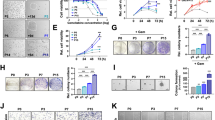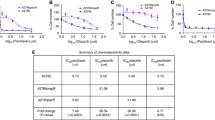Abstract
A doxorubicin-resistant human bladder carcinoma cell line RT112/D21 was established by continuous exposure of the parental line RT112 to increasing concentrations of doxorubicin over a period of 9 months. RT112/D21 cells expressed significantly more P-170 glycoprotein than the parental line, and rhodamine 123 efflux, as a functional parameter of P-170 glycoprotein activity, was increased. RT112/D21 cells were 96 times more resistant to doxorubicin than RT112 cells, and crossresistance to epirubicin and vinblastine was present. Sensitivity to methotrexate and mitomycin C remained unchanged. R-verapamil reversed resistance to doxorubicin, epirubicin and vinblastine in RT112/D21 cells but did not affect sensitivity to methotrexate and mitomycin C. In RT112 cells, R-verapamil had no effect on drug sensitivity. Thus, it may be assumed that primary or induced MDR1 gene-encoded P-170 glycoprotein expression is a relevant mechanism of chemoresistance in transitional cell carcinoma, and that chemotherapeutic strategies in combination with chemosensitizers improve response rates.
Similar content being viewed by others
References
Alley M, Scudiero DA, Monks A, Hursey ML, Czerwinski MJ, Fine DL, Abbott BJ, Mayo JG, Shoemaker RH, Boyd MR (1988) Feasibility of drug screening with panels of human tumor cell lines using a microculture tetrazolium assay. Cancer Res 48:589
Benson MC, Gielia J, Seong Whang I, Buttyan R, Hensle TW, Karp F, Olson CA (1991) Flow cytometric determination of the multidrug resistant phenotype in transitional cell cancer of the bladder: Implications and applications. J Urol 146:983
Bissett D, Kerr DJ, Cassidy J, Meredith P, Traugott U, Kaye SB (1991) Phase I and pharmacokinetic study of d-verapamil and doxorubicin. Br J Cancer 64:1168
Cole SPC, Downes HF, Slovak ML (1989) Effect of calcium antagonists on the chemosensitivity of two multidrug resistant human tumor cell lines which do not overexpress P-glycoprotein. Br J Cancer 59:42
Cole SPC, Bhardwaj G, Gerlach JH, Mackie JE, Almquist KC, Stewart AJ, Kurz EU, Duncan AMV, Deeley RG (1992) Overexpression of a transporter gene in a multidrug-resistant human lung cancer cell line. Science 258:1650
Echizen H, Brecht T, Niedergäss S, Vogelgesang B, Eichbaum M (1985) The effect of dextro-, levo-, and racemic verapamil on atrioventricular conduction in humans. Am Heart J 109:210
Efferth T, Löhrke H, Volm M (1989) Reciprocal correlation between expression of P-glycoprotein and accumulation of rhodamine 123 in human tumors. Anticancer Res 9:1633
FitzGerald DJ, Willingham MC, Cardarelli CO, Hamada H, Tsuruo T, Gottesmann MM, pastan I (1987) A monoclonal antibody-pseudomonas toxin conjugate that specifically kills multidrug-resistant cells. Proc Natl Acad Sci 84:4288
Floyd JW, Lin C-W, Prout GR Jr (1990) Multi-drug resistance of a doxorubicin-resistant bladder cancer cell line. J Urol 144:169
Ford JM, Hait W (1990) Pharmacology of drugs that alter multidrug resistance in cancer. Pharmacol Rev 42:155
Gerlach JH, Endicott JA, Juranka PF, Henderson G, Sarangi F, Deuchars KL, Ling V (1986) Homology between P-glycoprotein and a bacterial haemolysin transport protein suggest a model for multidrug resistance. Nature 324:485
Grant CE, Valdimarsson G, Hipfner DR, Almquist KC, Cole SPC, Deeley RG (1994) Overexpression of multidrug resistance-associated protein (MRP) increases resistance to natural product drugs. Cancer Res 54:357
Grogan T, Dalton W, Rybski J, Spier C, Meltzer P, Richter L, Greason M, Pindur J, Cline A, Scheper R, Tsuruo T, Salmon S (1990) Optimization of immunocytochemical P-glycoprotein assessment in multidrug-resistant plasma cell myeloma using three antibodies. Lab Invest 63:815
Gruber A, Peterson C, Reizenstein P (1988) d-verapamil and l-verapamil are equally effective in increasing vincristine accumulation in leukemic cells in vitro. Int J Cancer 41:224
Harris AL, Hochhauser D (1992) Mechanisms of multidrug resistance in cancer treatment. Acta Oncol 31:205
Herr HW, Laudone VP, Whitmore JWF (1987) An overview of intravesical therapy for superficial bladder tumors. J Urol 138:1362
Herweijler H, Engh G, Nooter K (1989) A rapid and sensitive flow cytometric method for the detection of multidrug-resistant cells. Cytometry 10:463
Hill BT, van der Graaf WT, Hoskin LK, de Vries EG, Mulder NH, Whelan RD (1993) Evaluation of S9788 as a potential modulator of drug resistance against human tumour sublines expressing different resistance mechanisms in vitro. Int J Cancer 55:330
Kartner N, Evernden-Porelle D, Bradley G, Ling V (1985) Detection of P-glycoprotein in multidrug-resistant cell lines by monoclonal antibodies. Nature 316:820
Kimiya K, Naito S, Soejiraa T, Sakamoto N, Kotoh S, Kumazawa J, Tsuruo T (1992) Establishment and characterization of doxorubicin-resistant human bladder cancer cell line, KK47/ADM. J Urol 148:441
Kruh GD, Chan A, Myers K, Gaughan K, Miki T, Aaronson SA (1994) Expression of complementary DNA library transfer establishes mrp as a multidrug resistance gene. Cancer Res 54:649
Lin Wu, Smythe AM, Sherman FS, Mullendore LA, Monks A, Scudiero DA, Paull KD, Koutsoukos AD, Rubinstein LV, Boyd MR, Shoemaker RH (1992) Multidrug-resistant phenotype of disease-orientated panels of human tumor cell lines used for anticancer drug screening. Cancer Res 52:3029
Ludescher C, Thaler J, Drach D, Drach J, Spitaler M (1992) Detection of activity of P-glycoprotein in human tumour samples using rhodamine 123. Br J Haematol 82:161
Lukkarinen O, Paul C, Hellstrom P, Kontturi M, Nurmi M, Puntala P, Ottelin J, Tammeala T, Tidefeldt U (1991) Intravesical epirubicin with and without verapamil for the prophylaxis of superficial bladder tumours. Scand J Urol Nephrol 25(1):25
McGovern F, Kachel T, Vijan S, Schiff S, Lin C, Prout GR Jr (1988) Establishment and characterization of a doxorubicinresistant human bladder cancer cell line (MGH-U1R). J Urol 140:410
Mickisch G, Bier H, Bergler M, Bak M, Tschada R, Alken P (1990) P-170 glycoprotein, glutathione and associated enzymes in relation to chemoresistance of primary human renal cell carcinomas. Urol Int 45:170
Mickisch GH, Roehrich K, Koessig J, Forster S, Tschada R, Alken P (1990) Mechanisms and modulation of multidrug resistance in primary human renal cell carcinoma. J Urol 144:755
Mirski SEL, Gerlach JH, Cole SPC (1987) Multidrug resistance in human small cell cancer cell line selected in adriamycin. Cancer Res 47:2594
Moriyama M, Sugawara I, Hamada H, Tsuruo T, Kato T, Sato K, Hikage T, Watanuki T, Mori S (1991) Elevated expression of P-glycoprotein in kidney and urinary bladder cancers. Tohoku J Exp Med 164:191
Mosmann T (1983) Rapid colorimetric assay for cellular growth and survival: application to proliferation and cytotoxicity assay. J Immunol Methods 65:55
Naito S, Sakamoto N, Katoh S, Goto K, Matsumoto T, Kumazawa J (1992) Correlation between the expression of P-glycoprotein and the multidrug-resistant phenotype in transitional cell carcinoma of the urinary tract. Eur Urol 22:158
Nakagawa M, Schneider E, Dixon KH, Horton J, Keley K, Morrow C, Cowan KH (1992) Reduced intracellular drug accumulation in absence of P-glycoprotein (mdr1) overexpression in mitoxantrone-resistant human MCF-7 breast cancer cells. Cancer Res 52:6175
Nooter K, Herrweijer H (1991) Multidrug resistance (mdr) genes in human cancer. Br J Cancer 63:663
Ohi Y, Ohmori H, Shirahama T, Kawahara M, Matsumara Y, Tsushima T, Ohashi Y (1992) Intravesical instillation of adriamycin in the presence or absence of verapamil for the treatment of superficial bladder cancer: preliminary report of a collaborative study. Cancer Chemother Pharmacol 30[Suppl]:50
Raghu G, Pierre-Jerome M, Dordal MS, Simonian P, Bauer KD, Winter JN (1993) P-glycoprotein and alterations in the glutathione/glutathione-peroxidase cycle underlie doxorubicin resistance in HL-60-R, a subclone of the HL-60 human leukemia cell line. Int J Cancer 53:804
Rassweiler J, Hath U, Bub P, Eisenberger F (1988) Intravesicale Langzeitchemoprophylaxe mit Mitomycin C beim oberflächlichen Harnblasenkarzinom — Rezidivverhalten und Progression nach 3 Jahren. Aktuelle Urol 19:139
Remmele W, Stegner HE (1986) Rezeptorbestimmung im Mammakarzinomgewebe. Dtsch Ärzteblatt 83:11
Rivoltini L, Colombo MP, Supino R, Dallinari D, Tsuruo T, Parmiani G (1990) Modulation of multidrug resistance by verapamil or mdr1 anti-sense oligodesoxynucleotide does not change the high susceptibility to lymphokine-activated killers in mdr resistant human carcinoma (LoVo)line. Int J Cancer 46:727
Sekine H, Fukui I, Yamada T, Ohwada F, Yokokawa M, Ohshima H (1994) Intravesical mitomycin C sequential therapy for carcinoma in situ of the bladder: a longer followup result. J Urol 151:27
Simpson WG, Tseng MT, Anderson KC, Harty JJ (1984) Verapamil enhancement of chemotherapeutic efficacy in human bladder cancer cells. J Urol 132:574
Sternberg CN, Yagoda A, Scher HI, Watson RC, Herr HW, Morse MJ, Sogani PC, Vaughan D Jr, Bander N, Weiselberg LR, Geller N, Hollander PS, Lipperman R, Fair WS, Whitmore WF Jr (1988) M-VAC (methotrexate, vinblastine, doxorubicin and cisplatin) for advanced transitional cell carcinoma of the urothelium. J Urol 139:461
Suzukake K, Vistica BP, Vistica DT (1983) Dechlorination of l-phenylalanine mustard by sensitive and resistant tumor cells and its relationship to intracellular glutathione content. Biochem Pharmacol 32:165
Tsuruo T, Indan H, Tsukagoshi S, Sukarai Y (1991) Overcoming of vincristine resistance in P388 leukemia in vivo and in vitro through enhanced cytotoxicity of vincristine and vinblastine by verapamil. Cancer Res 41:1967
Author information
Authors and Affiliations
Rights and permissions
About this article
Cite this article
Seemann, O., Muscheck, M., Siegsmund, M. et al. Establishment and characterization of a multidrug-resistant human bladder carcinoma cell line RT112/D21. Urol. Res. 22, 353–360 (1995). https://doi.org/10.1007/BF00296874
Received:
Accepted:
Issue Date:
DOI: https://doi.org/10.1007/BF00296874




